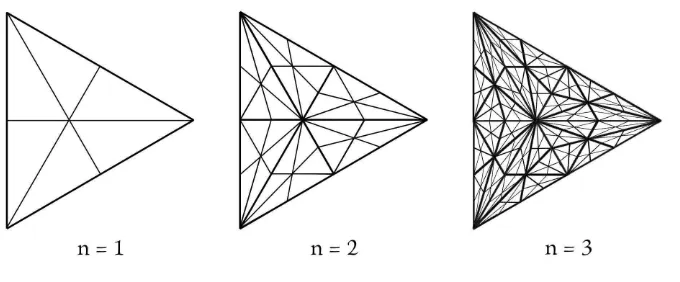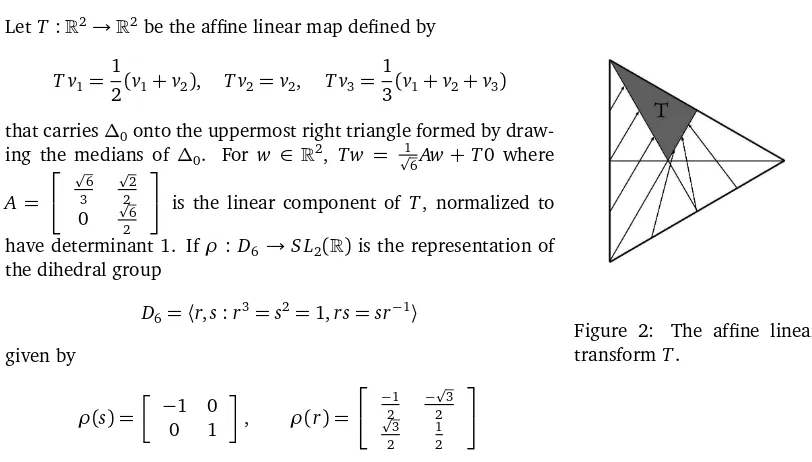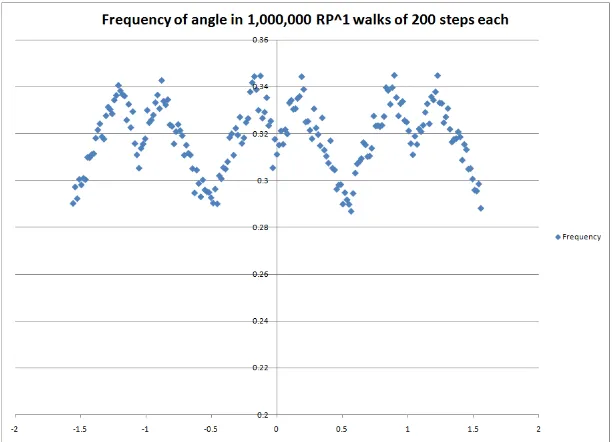ELECTRONIC COMMUNICATIONS in PROBABILITY
TESSELLATION OF A TRIANGLE BY REPEATED BARYCENTRIC
SUBDIVISION
BOB HOUGH
Department of Mathematics, Stanford University, 450 Serra Mall, Bldg. 380, Stanford, CA 94305-2125, USA
email: [email protected]
SubmittedNovember 14, 2008, accepted in final formMay 27, 2009 AMS 2000 Subject classification: 60D05, 60J10, 52B60, 52C45
Keywords: Barycentric subdivision, flat simplices, random walk on a group
Abstract
Under iterated barycentric subdivision of a triangle, most triangles become flat in the sense that the largest angle tends toπ. By analyzing a random walk onS L2(R)we give asymptotics with explicit constants for the number of flat triangles and the degree of flatness at a given stage of subdivision. In particular, we prove analytical bounds for the upper Lyapunov constant of the walk.
1
Introduction
The iterated barycentric subdivision of a triangle∆ is defined as follows. In the first stage the three medians are drawn resulting in six smaller triangles∆1through∆6. At stage 2 the process is repeated in each∆i, 1≤i≤6, producing in 36 triangles∆i j, 1≤i,j≤6. In general, on thenth
stage the medians are drawn in each triangle produced in the n−1st stage, so that 6ntriangles
∆i1...in,1≤i
1, ...,in≤6, result. We ask: asngrows do the triangles in stagenbecome “flat”, in the
sense that they have largest angle approachingπ?
It is not hard to show that not all triangles that result from barycentric subdivision become flat: if ∆ =ABChasm(A)≤m(B)≤m(C), with centroidOandX the midpoint ofBC, then it is a nice exercise in Euclidean geometry to check that the least angle in COX is at least min(m(A), 30◦); in particular, min(m(A), 30◦) is a lower bound on the maximum least angle appearing among triangles in the nth stage of subdivision, for any n. Nonetheless, Stakhovskii has proposed that as n→ ∞nearly one hundred percent of all triangles at stagenhave largest angle nearπ and in 1996 Bárány, Beardon and Carne[1]gave an elegant proof of this conjecture. They identify iterated barycentric subdivision with a random walkXnonS L2(R), the triangles at thenth stage of subdivision being similar to the images of∆underXn. Their key observation is that the generators
of the random walk generate a dense subgroup ofS L2(R), and so a theorem of Furstenberg[6] implies that there existsγ >0 such that for anyv∈R2, limn
→∞1nlogkXnvk=γwith probability
1. (Thisγis called the upper Lyapunov constant of the random walk.) It then follows easily that almost all triangles become flat.
Figure 1: The first three stages of barycentric subdivision for equilateral∆
While the argument[1] (rediscovered independently in[4]with some generalizations) gives a very satisfactory characterization of barycentric subdivision as n → ∞, it has the disadvantage that the Ergodic Theoretic approach does not readily yield information for “finite” n. Recently Diaconis and Miclo[5] have given another formulation using iterated random function Markov chains that allows them to deduce more information about the limiting shape of triangles after many subdivisions, but this approach also does not translate easily to giving bounds for the number of triangles at a given stage having largest angle of a certain size. The strongest approach in this finite direction is due to David Blackwell [2], who has proved (at least computationally) that barycentric subdivision decreases a certain “pseudo-fatness” metric on average.
In the following I give a hybrid of the methods of[2]and[1]together with a relatively simple geometric construction, which yields an explicit lower bound tending to 1 for the proportion of triangles in stagenhaving largest angle in a certain range. This range converges toπexponentially quickly with respect ton; in particular, I obtain analytic upper and lower bounds for the constant
γ, which, while not matching, can be made to giveγto arbitary precision by working with later stages of subdivision.
Acknowledgements. I would like to thank Persi Diaconis for introducing me to this problem, for several references, and for his advice in writing this paper. I am also grateful to Persi and his collaborators Curt McMullen and Laurent Miclo for sharing manuscripts with me that are still in progress. I owe my concluding argument with Azuma’s inequality to the first referee. Finally, I thank Fai Chandee, Leo Goldmakher and Xiannan Li for helpful comments.
2
Formalism
Embed∆⊂R2with the standard basis, and let∆
0be the equilateral triangle with vertices
Figure 2: The affine linear that carries∆0onto the uppermost right triangle formed by draw-ing the medians of ∆0. For w ∈ R2, Tw = p16Aw+T0 where
is the linear component of T, normalized to
have determinant 1. Ifρ:D6→S L2(R)is the representation of
reflection in thex-axis and rotation by2π
3 respectively, then writingT
xforρ(x)◦T◦ρ(x)−1,x∈
D6, a collection of affine linear maps carrying∆0onto∆1
0, . . . ,∆60is
TD6={Tx:x∈D6},
andAD6 is the corresponding collection of normalized linear components of these maps.
For affine linear map Sw = λBw+v, detB = 1 carrying ∆0 onto ∆, linearity of barycentric subdivision implies that the six triangles ∆i are the images underS of the six triangles ∆i
0. In particular, if we letµbe the uniform distribution onAD6 and define the usualn-fold convolution
µ(n)=µ∗ · · · ∗ntimesµ= 1 6n
X
M1,...,Mn∈AD6
δM1...Mn,
then, up to dilation and translation, the distribution of triangles appearing in∆0afternstages of barycentric subdivision is given by Y∆0, where Y is chosen fromS L2(R)according toµ(n), and
the distribution of triangles in∆is given byBY∆0.
The following observations allow us to reformulate statements about barycentric subdivision in terms of operators inS L2(R).
Observation 2. With A the linear component of T defined above andk · kthe operator normkBk= supv∈R2:kvk=1kBvkwe haveα:=kAk=
q
4+p7 3 .
For a proof of these calculations see the notes at the end. Observation 1 shows that the difference betweenπand the largest angle in∆i1...in
kBk−1kxk ≤ kB xk ≤ kBkkxkforB∈S L
2(R)andx∈R2implies that if∆
i1...in
0 is sufficiently flat, the distances fromπof the largest angles in∆i1...in
0 and(B∆0)i1...in are within a factor ofπ2kBk2, so that henceforth we consider only barcentric subdivision of ∆0 and restrict our attention to describing the distribution ofkY vkforva unit vector andY chosen fromµ(n).
Theorem 1. Withµdefined as above, v an arbitrary unit vector inR2and for anyλ >0
µ(n){M∈S L2(R):
0.05857n−0.8874λpn<logkM vk<0.09461n+0.8874λpn
≥1−2e−λ2/2. Here the numerical constants 0.05857 and 0.09461 come from solving a certain algebraic equation pertaining to the dilatation of a circle under the operatorA, above, while 0.8874 bounds the step size in a random walk.
Specializing our result toλ=p2 lognwe have
e0.05857n−1.255pnlogn≤ min
i=1,2,3kYnsik ≤i=max1,2,3kYnsik ≤e
0.09461n+1.255pnlogn
with probability at least 1− 6n. Applying this with observation 1, (and recalling that As2 = p
3 4 in an equilateral triangle) we obtain that in the nth stage of barycentric subdivision of∆0, the proportion of triangles having largest angleθ with
πp3
2 e
−0.11714n+2.51(nlogn)1/2
> π−θ >
p 3 2 e
−0.18921n−2.51(nlogn)1/2
is at least 1−6
n.
3
Proof of Theorem
Define random walk Y0,Y1,Y2, ... onS L2(R)byY0= I,Yi =XiYi−1fori≥1 where X1,X2, ... are chosen i.i.d. fromµ. Thus,µ(n)is the measure ofY
n. Forvan arbitary unit vector inR2, the walk Yninduces a natural random walkYnvonR2. The random differenceZn=logkYnvk −logkYn−1vk depends only on the directionvn−1=
Yn−1v
kYn−1vk
and is bounded:−logkAk ≤Zn≤logkAk. We show that independent of the directionvn−1,C≥E[Zn]≥c>0 and deduce the listed bounds forkYnvk
by the method of bounded differences.
Letw∈R2\ {0}be arbitrary. GivenX chosen fromAD6according toµ, we have
E[logkX wk −logkwk] =E[logkX wk] =1 6log
Y
x∈D6
kAxwk,
withw= w
kwk. NowAmay be expressed asU1DU2whereU1andU2are unitary matrices andDis
a diagonal matrix such thatkDk=kAk, i.e. we may takeD=
α 0
0 α−1
whereα=kAk. Since
ρ(x)is unitary for eachx we have
E[logkX wk] =1 6log
Y
i∈{0,1,2},j∈{0,1}
Note that the triples of vectors [U2w,U2r w,U2r2w] and [U
2sw,U2rsw,U2r2sw] each form the sides of an equilateral triangle. Thus by the symmetryw ↔sw we have the bounds 1
6logβ
Proof. Choose coordinates so thatDexpands the xdirection and contracts the y direction. With-out loss of generality,wis in the upper half plane, i.e.
w= (cosθ, sinθ), r w=
This is a degree six polynomial inx. Indeed,y2=1−x2so the first term has degree 2. Distributing the two bracketed terms gives
α4
The two terms in parentheses are degree 4, while the two in brackets sum to 3 8+2x
2y2, which is also degree 4.
Since f(x)is degree 6 in x, f′(x)has at most 5 zeros on[−1, 1]. Now calculate the maxima and minima another way. Write
f(x) =g(θ) =
and take the logarithmic derivative:
g′(θ)
This expression is π
3-periodic and vanishes at 0 and π
2 since in each case one of the sine terms is zero while the other two cancel. Hence gg′ has a zero at k6π for all k. But then g′(θ) =
1The qualitative statementβ
f′(cosθ)sinθ, so we obtain all five zeros of f′(x)from θ = kπ
6, 1 ≤ k ≤ 5. Since any local maxima or minima ofg(θ), 0< θ < πtranslates to a local maxima/minima of f(x)on(−1, 1), we have found all extreme points ofg(θ)on this interval, hence for allθby periodicity. It follows thatβ2
so that by observation 2
g(0) = 172+7
It remains to describe the bounded differences argument proving almost certain exponential growth. Recall that Zn = logkYnvk −logkYn−1vk is the log-length increment of each step of
is a Martingale with increments bounded by
|Wn| ≤sup vn−1
|Zn|+sup vn−1
|E[Zn|vn−1]| ≤logkAk+δ+,
and hence by Azuma’s inequality
P
4
Remarks and related problems
Our constants δ− ≈ 0.05857 and δ+ ≈ 0.09461 give lower and upper bounds for the upper
Lyapunov constantγ:=limn→∞1
by averaging over the linear operators resulting from later stages of subdivision, but, as it stands, a result of typekYnvk=exp(γn−o(n))with probability 1−o(1)is beyond the limitations of our method. Based upon computer calculations,γ≈0.071. For a nice exposition of growth of random walks in matrix groups and Lyapunov constants see[3].
Barycentric subdivision also produces flat simplices in higher dimension (this is done in[4]). In dimensionkthe corresponding random walk is onS Lk(R)and the analogue of the dihedral group
D6is the symmetric groupSk+1. Furstenberg’s theorem applies as before, giving limn1nlogkYnvk= γ > 0. One might again expect to obtain upper and lower bounds forγ by allowing a(k+ 1)-cycleσto play the role of the rotationr in Lemma 2, although the explicit calculations become increasingly difficult.
Returning toR2, there remain interesting questions. Putθnfor the maximum of the least angles among triangles at stagen; in our introduction we sketched an argument thatθn≥min(θ0, 30◦). Pictures suggest that more is true, e.g. in stage 3 of subdivision of an equilateral triangle we already have sub-triangles that are almost equilateral. One conjectures thatθn→60◦ asn→ ∞
and exponentially quickly, although the best argument that I know applies only to subsequences of stages and is polynomial inn.
Figure 3: Frequency of angle in 106trials of theRP1random walk after 200 steps, starting from the uniform distribution.
Finally, our theorem shows that after many subdivisions most of the resulting triangles are rela-tively flat, so that they take on the direction of their longest side. One could ask for the distribution of these sides, asn→ ∞, which is closely related to stationary distribution of the random walk onRP1 defined by choosing v0∈RP1 according to some distribution and puttingvn =Xnvn−1, where the Xnare chosen independently uniformly from AD6. Such a limiting distribution exists
approximation of the distribution is shown above.
5
End notes
Proof of Observation 1. The largest angleθ of ∆lies opposite the longest side, that is, between the sides of lengthℓandm. HenceA = 1
2ℓmsinθ. Providedℓm> 4pA
3 we get sinθ <
p
3 2 and soθ ≥ π
3, by virtue of being the largest angle of a triangle, forcesθ ≥ 2π
3. The observation then follows from the identity sinθ < π−θ < πsinθ, valid for π
2< θ < π.
Proof of Observation 2. Forv= (cosθ, sinθ),
kAvk2=2 3cos
2θ+2 sin2θ+2 p
3
3 cosθsinθ = 4 3−
2
3cos 2θ+ p
3 3 sin 2θ.
This takes on its extreme values when tan 2θ=−p3
2 , i.e. for cos 2θ=±
Æ
4
7, sin 2θ =∓
Æ
3 7so we have the desired result.
References
[1] I. Bárány, A. Beardon, and T. Carne. Barycentric subdivision of triangles and semigroups of Möbius maps.Mathematika, 43:165–171, 1996. MR1401715
[2] D. Blackwell. Barycentric subdivision. Article in preparation, private communication, 2008.
[3] Philippe Bougerol and Jean Lacroix. Products of Random Matrices with Applications to Schrödinger Operators. Birkhäuser, 1985. MR0886674
[4] P. Diaconis and C. McMullen, Iterated barycentric subdivision. Article in preparation, private communication, 2008.
[5] P. Diaconis and L. Miclo. Iterated barycentric subdivision. Article in preparation, private com-munication, 2008.


